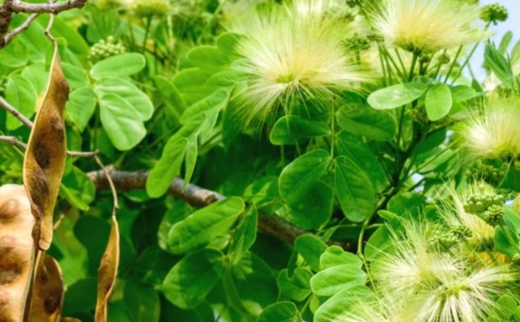Shirisha/ Woman’s tongue tree/ Albizia lebbeck Benth. – Ayurvedic Uses, Benefits, Dosage & Therapeutic Actions
Abstract
Albizia lebbeck is a widely used medicinal tree in traditional Indian medicine, particularly in Ayurveda, Unani, and Siddha systems. It is commonly known as Shirish in Sanskrit and is valued for its antihistaminic, anti-inflammatory and anti-asthmatic properties. Various parts of the tree, including the bark, leaves, seeds and flowers, are used for managing respiratory ailments, skin diseases, and allergic conditions. It also serves as an important detoxifying herb in Ayurvedic Panchakarma therapies. Owing to its diverse pharmacological benefits and widespread availability, Albizia lebbeck holds a significant place in both therapeutic and ecological domains.

Introduction
Albizia lebbeck (L.) Benth., commonly known as Lebbek tree or Woman’s tongue tree, is a fast-growing deciduous species of the Fabaceae family, native to tropical and subtropical regions. Traditionally, it is used in Ayurveda under the name “Shirisha,” and is considered one of the best anti-poisonous herbs. It is extensively used to treat respiratory issues, especially allergic rhinitis and bronchial asthma. The plant is also credited with wound healing, anti-inflammatory and anti-helminthic properties. In addition to its medicinal importance, the tree provides shade, improves soil fertility and supports agroforestry systems.
Scientific Classification
- Kingdom Plantae
- Class Magnoliopsida
- Order Fabales
- Family Fabaceae
- Genus Albizia
- Species Albizia lebbeck (L.) Benth.
Synonyms
- Kapitana – The flowers are yellowish in colour and resemble the face or hue of a monkey
- Mrudupushpa – The flowers are soft and delicate in texture
- Mandila – This name indicates the plant’s usefulness in treating many diseases, especially Kasa (cough)
- Shukapirya / Shukapushpa – The flowers resemble the beak of a bird (parrot-like appearance)
- Bhandi
- Bhandira
- Bhandila
- Shukataru
Vernacular Names
- Hindi name – Siris
- English name – Lebbeck, Lebbek Tree, Flea Tree, Frywood, Koko, Woman’s Tongue Tree
- Telugu name – Dirisena Chettu
- Tamil name – Vegiai
- Kannada name – Bage Mara
- Malayalam name – Vaga
- Punjabi name – Siri, Shari
- Gujarati name – Sarsado
- Bengali name – Sirosh
- Marathi name – Siras
Habitat
Albizia lebbeck is cultivated in many parts of the world and has become naturalised across diverse regions, including Southeast Asia, Australia, Western Asia, North Africa, West Africa, the Caribbean, Central America and both northern and eastern regions of South America. The genus Albizia comprises approximately 150 species, which are widely distributed throughout the subtropical regions of Asia and Africa. In India, Albizia lebbeck is found throughout the country and is also common in the neighbouring eastern regions of Pakistan, Sri Lanka, and Myanmar (formerly Burma), where it thrives in both natural forests and cultivated landscapes.
Morphology
Albizia lebbeck is a medium to large deciduous tree with greyish bark marked by longitudinal and transverse fissures; the inner bark is slightly reddish with fine striations. The heartwood is dark brown, hard, coarse, and splintery, with an astringent taste and resinous aroma. Leaves are bipinnate with 3–11 pairs of oblong leaflets, bright green above, folding at dusk, and showing nyctinastic movement. Flowers are fragrant, white, and borne in globular clusters, with numerous long stamens and soft, downy lobes. The pods are flat, leathery, glabrous, light yellowish-brown and indehiscent, containing 3–12 creamy-brown seeds. The mature pods remain on the tree before naturally detaching.
Varieties
There is another species of Shirish, which is called Albizia odoratissima, the black Shirish. It has 2 to 5 pairs of sub-petals; leaflets are 12-30 mm long, 6 to 24 pairs are stemless. It has a gland at the base of the main petiole and the stem of the upper 1-2 sub-petals. Flowers are grey, sessile and come on the stem. Pods are 15-30 cm long, 25-30 mm wide, translucent or shiny and contain 8-12 seeds. Another variety of it is white Shirish. It is called A. procera. Its bark is white or greenish white, sub-parts are 3-6 pairs and leaflets are 5-11 pairs, 25 to 55 mm long. The flower-heads are like black Shirish. Pod- 10-20 cm. x 1-2.5 cm., brown and contains 8-12 seeds. It is called Kinhai in Marathi.
Special Note
Trichodesma zeylanicum R. Br./ Jal Shirisha
It has not been decided yet what Jal Shirisha is. It is possible that there is a tree like Shirisha that grows near water. The Marathi name ‘Jal Shirsi’ is found written for Trichodesma zeylanicum R. Br., which is more likely to be Jal Shirishika. Acharya Priyavratji has expressed the possibility of Dalbergia volubilis Roxb. for Shirishika (DravyaGuna Vigyan). It is considered a variety of Gaurakh in Varanasi, which balances Vata dosha.
Classical Categorisation
According to Charaka Samhita –
- Vishaghna – Group of anti-poisonous herbs
- Vedanasthapana – Analgesic group of herbs
- Shirovirechana – Group of herbs used to cleanse and detoxify the sense organs and brain
- Kashaya Skanda – Astringent group of herbs
According to Sushruta Samhita – Salsaradi Gana
According to Ashtanga Hridaya (Vagbhata) – Asanadi Gana
According to Bhavprakash Nighantu – Vatadi Varga
Ancient Verses
शिरीषो मधुरोऽनुष्णस्तिक्तश्च तुवरो लघुः ।
दोषशोथविसर्पघ्नः कासव्रणविषापहः ॥
According to the above shloka, Shirish has Sweet, bitter and astringent taste, a little bit hot in potency and light in nature. It is effective in the management of inflammation, erysipelas, cough, wounds and poison.
Ayurvedic Properties
- Taste (Rasa) – Bitter (Tikta), Sweet (Madhur), Astringent (Kashaya)
- Physical Property (Guna) – Light (Laghu)
- Potency (Veerya) – Little Hot Potency (Usna)
- Post-Digestion Effect (Vipaka) – Katu (Pungent)
- Effect on Tridosha – Balance Vata, Pitta and Kapha dosha
Therapeutic Properties
- Shothahara – Helps reduce inflammation and swelling
- Visarpaghna – Effective in managing herpes and spreading skin conditions
- Kasahara – Alleviates cough, cold, and respiratory irritation
- Vranahara – Promotes rapid healing of wounds and ulcers
- Vishapaha – Beneficial in neutralising toxins and managing poisoning
- Varnya – Enhances skin health and improves natural complexion
- Kushtaghna – Supports the treatment of various skin disorders
- Kandughna – Relieves itching and skin irritation (pruritus)
- Twak Doshahara – Purifies and detoxifies the skin
- Shwasahara – Aids in conditions like asthma, COPD and breathing difficulties
Systemic Actions
External Uses
The paste of Albizia lebbeck seeds is known for its anti-inflammatory, analgesic and detoxifying properties. It enhances skin complexion and is traditionally used in Nasya therapy and as an eye treatment. Seed paste is particularly effective in managing swollen lymph nodes. Bark paste is applied externally to improve skin tone, while a decoction of the bark is used for gargling in cases of dental decay and oral infections. Leaf juice is used as eye drops in certain eye ailments, and seed powder serves as Anjana (collyrium). These preparations are highly recommended in various toxic and poisonous conditions.
Internal Uses
- Digestive System – The herb acts as an absorbent and supports digestion. However, excessive intake may lead to vomiting.
- Respiratory System – It helps balance Kapha dosha and is useful in conditions such as cough, rhinitis, and breathing difficulties. Seed powder is administered via Nasya to treat kapha-dominant disorders. A mixture of the flower juice with Pippali powder and honey is effective in asthma. Herbal confections (leha) made from the plant are also beneficial in respiratory complaints.
- Circulatory System – It has anti-inflammatory action. Bark decoction is especially indicated in conditions like Visarpa (erysipelas) and cervical lymphadenitis.
- Reproductive System – Seed powder combined with milk acts as an aphrodisiac and is useful in treating oligospermia. The flowers have Sukrastambhaka (semen-stabilising) properties.
- Satmikarana – Both bark decoction and seed powder are traditionally used as supportive treatments in all forms of poisoning.
- Skin – Widely indicated in various dermatological conditions, helping manage skin disorders effectively.
Chemical Composition
Triterpenoids & Sterols
- Lupeol
- Stigmasterol
- β-sitosterol
- γ-sitosterol
- α-amyrin
- β-amyrin
- Friedelin
- Friedelan-3-one
- Campestrol
- Sitosterol
- Stigmast-4,20(21),23-trien-3-one (Lebbeksterone)
- Echynocystic acid
- Taxerol
- Cycloartemol
Phenolic Compounds & Acids
- 4-hydroxy-3-methoxycinnamic acid
- Trans-p-coumaric acid
- D-catechin
- Leucocyanidin
- Mekacacidin
- Leucoanthocyanidin
- Lebbecacidin
- Melacacidin (7,8,3’,4’-tetrahydroxyflavan-3,4-diol)
- Leucopelargonidin
- Quercetin
- Kaempferol
- Kaempferolquercetin
- Melanoxetin
- Okanin
Saponins & Glycosides
- Acacic acid lactone 3-O-β-D-xylopyranosyl-(1→2)-α-L-arabinopyranosyl-(1→6)-β-D-glucopyranoside
- 3-O-β-D-xylopyranosyl-(1→2)-α-L-arabinopyranosyl-(1→6)-O-[β-D-glucopyranosyl (1→2)-β-D-glucopyranoside]
- Hexaglycosylated saponins
- Anthraquinone glycosides
- Albizziahexoside
Fatty Acid Esters
- Tricosanyloctadec-9-en-1-oate
- Pentacosanyloctadec-9-en-1-oate
Flavonoids
- Flavone, 3’,5-dihydroxy-4’,7-dimethoxyflavone
Alkaloids & Related Compounds
- N-benzoyl-L-phenylalaninol
- Albigenic
- Albigenin
- Albizzin
- Lebbekanin
- Lebbekannin-D, F, G & H
Other Organic Compounds
- D-pinitol
- Benzyl acetate
- Benzyl benzoate
- Crocetin
- Crocetin lebbekannin derivatives
Proteins And Nutrients
- Protein
- Ascorbic acid (Vitamin C)
- Niacin
Minerals
- Calcium, Phosphorus, Iron
Amino Acids
- Arginine
- Histidine
- Leucine
- Isoleucine
- Lysine
- Methionine
- Phenylalanine
- Threonine
- Tyrosine
- Valine
Modern Overview
For Respiratory Problems
Albizia hexoside glycosides, present in Albizia lebbeck, exert their therapeutic effects in respiratory disorders through multiple mechanisms. These compounds possess strong anti-inflammatory properties that help reduce airway inflammation and swelling, which are central features of asthma and bronchitis. They also stabilise mast cells, thereby preventing the release of histamine and other mediators responsible for allergic reactions and bronchoconstriction. This anti-anaphylactic action makes breathing easier and prevents sudden asthma attacks. Additionally, other phytochemicals in the plant, such as saponins and flavonoids, act as expectorants and bronchodilators, aiding in mucus clearance and improving airflow. Together, these properties support its traditional use in treating coughs, colds, asthma, and other respiratory conditions.
Antimicrobial Activity
In Albizia lebbeck, anthraquinone glycosides contribute significantly to its antimicrobial action. These compounds exert their effect by disrupting the integrity of microbial cell membranes, leading to leakage of essential intracellular contents. They also intercalate into microbial DNA, inhibiting replication and transcription processes, which hampers bacterial and fungal growth. Furthermore, anthraquinone glycosides induce oxidative stress by generating reactive oxygen species (ROS), which damage cellular proteins and nucleic acids. Their glycosidic component improves solubility, aiding in better absorption and cellular penetration. These mechanisms collectively explain the broad-spectrum antimicrobial efficacy of Albizia lebbeck against various bacterial and fungal pathogens.
Anti-Poison Activity
Melacacidin and Albizia hexoside glycosides are key phytoconstituents of Albizia lebbeck that contribute significantly to its traditional use as an anti-poison herb. Melacacidin, a type of flavonoid, exhibits potent antioxidant and membrane-stabilising effects, which help neutralise cellular damage induced by toxins. It also reduces lipid peroxidation and inhibits inflammatory mediators that are commonly elevated in toxic reactions. Albizia hexoside glycosides, a class of saponins, assist in detoxification by enhancing the excretion of toxins, modulating immune responses, and protecting liver cells, an organ crucial in metabolising poisons. Together, these compounds work by interrupting the biochemical cascade triggered by toxic substances, supporting both immediate and long-term recovery from poisoning.
Practical Uses
- Nasal Allergies & Sinusitis – Instilling 2–4 drops of fresh Shirish leaf juice in each nostril helps prevent seasonal nasal allergies and sinus issues.
- Sexual Debility – Powdered Shirish seeds, when mixed with or boiled in milk, help improve sexual strength and stamina.
- Mental Disorders (Unmada & Apasmara) – A powdered mixture of equal parts Shirish seeds, Ashwagandha, Mulethi (Liquorice), Vacha, and dry ginger can be taken twice daily to support conditions like epilepsy (Apasmara) and mental instability (Unmada).
- Cough – Old, yellow Shirish leaves are sautéed in ghee on a low flame, mixed with honey, and consumed to ease coughing.
- Diarrhea – Half a gram of powdered Shirish seeds can be taken to control and relieve diarrhea.
- Liver Disorders & Ascites – A decoction prepared by boiling 10 grams of Shirish bark in 200 ml of water until 50 ml remains helps in liver ailments, ascites, and detoxification by promoting diuresis.
- Non-Healing Ulcers – Fine powder made from dried Shirish (Albizia lebbeck) bark can be dusted directly over chronic, non-healing ulcers to promote healing.
- Herpes & High Pitta Skin Disorders – A paste made from fresh Shirish bark or leaves can be applied topically to skin conditions like herpes, blisters, or any Pitta-aggravated skin disorders, especially those involving burning and itching.
- Dental Health – Due to its antibacterial nature, a decoction (Kashayam) prepared from Shirish bark is used as a gargle for oral hygiene. Additionally, the Shirish stem was traditionally used as a natural toothbrush.
- Poison Management – For insect or animal bites (snake, spider, rat, scorpion), a topical paste made from Shirish seeds and Pippali (Piper longum) is applied along with Calotropis procera (Aak) latex for detoxification.
- Erysipelas (Visarpa) – A topical paste made from equal parts of Amaltas (Cassia fistula) leaves, Lasoda (Cordia myxa) bark, and Shirish flowers helps reduce inflammation and discomfort in erysipelas.
- Eye Disorders – Fresh juice of Shirish leaves (2 drops) can be instilled in each eye to prevent seasonal allergies, night blindness, and excessive watering of the eyes.
- Earache – Slightly warmed Shirish leaves are crushed to extract juice, which can be dropped into the ears to relieve pain.
- Eczema & Psoriasis – Dried Shirish leaves are burned in a clay pot, and the resulting ash is mixed with cow’s ghee or mustard oil. This mixture is applied to areas affected by eczema or psoriasis for relief.
- Headache & Migraine – A paste made from Shirish flowers can be applied to the forehead to alleviate headaches, particularly migraines.
Part Used
- Bark
- Seeds
- Leaves
- Flowers
Dosage
- Powder – 3–6 gm
- Decoction – 50–100 ml
- Fresh Juice – 10–20 ml
Ayurvedic Medicines
- Dashang Lepa
- Devadarvarista
Planet Ayurveda Medicines
Conclusion
Shirish (Albizia lebbeck) is a highly revered Ayurvedic herb known for its powerful Vishaghna (anti-toxic), Krimighna (antiparasitic), and Shothahara (anti-inflammatory) properties. It plays a vital role in managing a wide spectrum of disorders ranging from skin diseases, respiratory allergies, and poisonings, to neurological, digestive, and reproductive issues. Its usage in various forms, such as leaf juice, bark powder, seed decoction, and paste, demonstrates its multifaceted therapeutic applications. Shirish not only detoxifies the body but also rejuvenates the tissues and boosts immunity, making it an indispensable herb in classical Ayurvedic practice for both internal and external healing.



